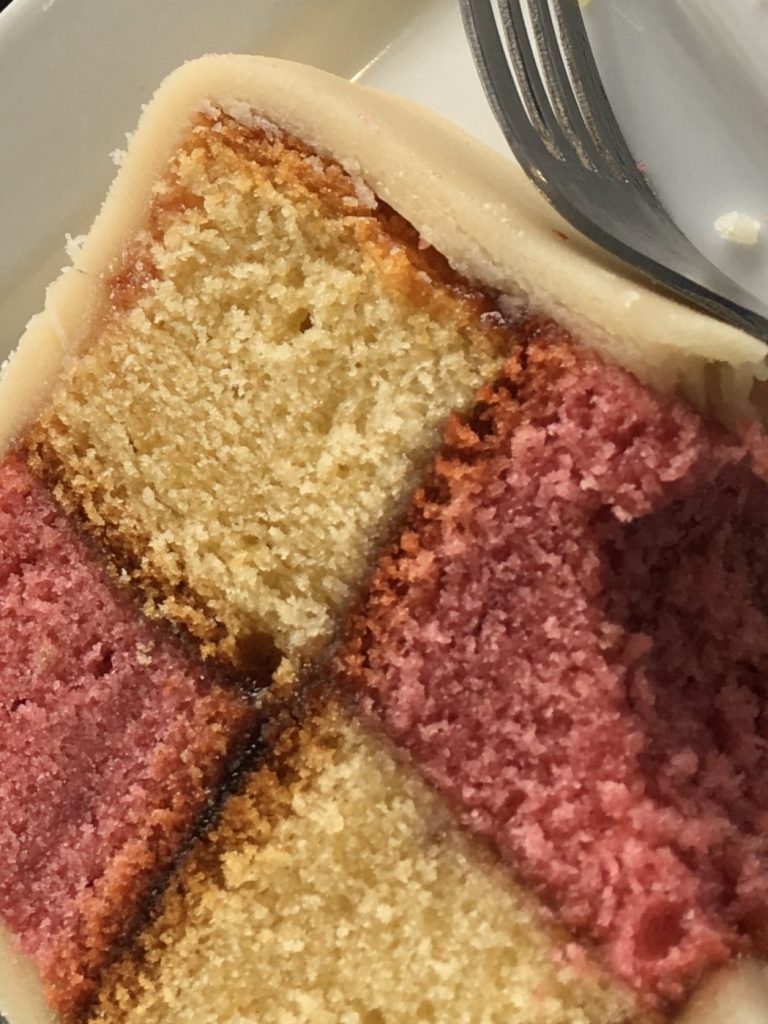I have spent a long morning immersed in English history in the Great Hall at Carisbrooke Castle, trying to untangle the web of European connections that is the British Royal Family. What better way, then, to blow away the cobwebs than at the Breeze Restaurant at Island Harbour Marina on the outskirts of Newport? Directed there by the chance remark of a colleague, I am now on the veranda overlooking a phalanx of masts, taste-testing a piece of Battenberg Cake with a caffè latte .

Bizarrely, this slice of cake is also related to my busy morning with Queen Victoria’s family tree. A chequered confection of pink and yellow squares pasted together with strawberry jam and enveloped in marzipan, the Battenberg was named for Queen Victoria’s granddaughter, another Victoria, who married Prince Louis of Battenberg in 1884. Mother of Louis, 1st Earl Mountbatten of Burma, grandmother of the Duke of Edinburgh, sister to Elizabeth, who became a Grand Duchess of Russia, and Alix, otherwise known as the Tsarina of Russia, Alexandra Feoderovna. And her brother-in-law, Prince Henri Battenberg, later married her Aunt Beatrice, Queen Victoria’s youngest daughter. I told you it was a tangled web.
The discovery of the Battenberg cake led me on to other foods named for royalty, often devised for a royal wedding or a state occasion, and it quickly became apparent that christening food after the aristocracy or a local celebrity was once very fashionable, particularly in the 19th century. Although many of these regal dishes only had a moment or two of glory, some have survived the test of time. How about a Gateaux Alexandra, for Edward VII’s wife, Queen Alexandra? Or a consommé for her great-niece Alice? Edward VII, a renowned gourmand, had a potato, an apple and a chicken dish stuffed with foie gras named after him. And the popular cocktail, Bloody Mary (vodka, Worcestershire sauce and tomato juice), got its name from that violent and vengeful English Queen, Mary Tudor.
Then there is the greengage plum, which derived its name from Sir William Gage, an early 18th century MP, who brought the fruit over to England from France, where it was known as Reine Claude, after the wife of the 16th century King Francis.
The Margherita pizza, in the colours of the freshly minted Italian flag, was named for Queen Margherita of Savoy (1851–1926), to commemorate her visit to Naples in 1889, while Stroganoff was a 19th century Russian count who became a beef and cream dish. And Beef Wellington was reputedly named in honour of the Iron Duke, who led British forces to victory at the Battle of Waterloo.
Woolton pie was made from root vegetables, created by the chefs at the Savoy to support Frederick Marquis, 1st Earl of Woolton, the British Minister of Food during World War II , who went to huge lengths to persuade people to eat more vegetables and less meat as part of the war effort.
Another cake, similar to the Battenberg (sponge cake and raspberry jam wrapped in green marzipan) was also named for a princess. Three princesses, in fact. Margaretha, Martha and Astrid were the daughters of a Scandinavian prince, who subsequently became the queens of Norway, Denmark and Belgium, and princess cake, invented by their nanny, was a firm favourite with the girls, apparently.
More recently, Filet de Sole Mountbatten and Bombe Glacée Princess Elizabeth were served at the wedding of Queen Elizabeth and Prince Philip. And let’s not forget that coronation chicken salad with mangoes and almonds was invented for her coronation in 1953. There was even a Soufflé Diana created by the chef at one of the Princess of Wales’ favourite restaurants.
Now, pick the celebrity in a Bismarck herring, Bonaparte’s ribs (a popular sweet in the 19th century), a Shirley Temple or a Chateaubriand, Peach Melba and Pavlova…
*
Queen Victoria was reputedly responsible for formalizing dining etiquette that lives on today, but at least you won’t be asked to join her for dinner. Renowned as a glutton (although no one would have dared to say it aloud) QV was known to eat so fast that many of her guests never had the chance to finish their meals. As everyone was served after the Queen, and plates were cleared away as soon as the monarch put down her knife and fork, those served last would barely have managed a spoonful. Luckily there were plenty of courses, so hopefully the odd mouthful made its way to her guests stomachs, despite her race to the finish line.
Royal banquets have always been formal affairs, in fact, from Charles II to Henry VIII and right back through the centuries to William the Conqueror. Such feasts would have been incredibly extravagant and elaborate, with multiple courses and hundreds of dishes. It was the perfect way to show off one’s wealth and privilege, not to mention one’s knowledge of civilized and sophisticated behaviour. Table settings became increasingly ostentatious, and there was a very strict code of etiquette, even before there were knives and forks to eat with. Burping at the table and messy eating, for example, were completely unacceptable. Seating was hierarchical, and it was a huge honour to sit close to the King, provided you didn’t take advantage and try to poison him – and there were special tasters of the royal food to make sure that didn’t happen.
All this talk about food has made me hungry. So what’s there to eat? Coronation chicken sandwiches perhaps? Or a slice of Victoria sponge?
